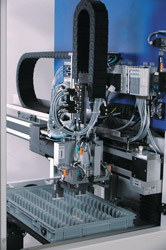
Posted to News on 8th Jun 2015, 14:09
Palletisers and depalletisers - make or buy?
Andrew Mason, the Automation Sales Manager at R.A. Rodriguez (U.K.) Limited, discusses palletisers and depalletisers, and the important question of whether it is better for machine builders to design and manufacture their own or buy-in complete standard or customised units.

Factory automation often involves machinery that outputs discrete parts, sub-assemblies or assemblies that then need to be palletised. Also, automated assembly, inspection and/or test equipment often has to receive parts, sub-assemblies or assemblies that are delivered in trays or pallets. Machine builders are therefore faced with the dilemma of whether to design and build palletisers and depalletisers in-house or purchase complete units that have been manufactured and tested by specialists, whether those units are standard designs that have been configured to order or to some extent customised. Sometimes the "make or buy?' decision is straightforward, but there are situations in which it is less clear cut.
A palletiser/depalletiser may comprise a simple three-axis Cartesian system plus a gripper for the pick-and-place function and, operating in conjunction with this, a mechanism for stacking/unstacking full/empty pallets as appropriate - or sometimes the palletiser/depalletiser is just the pick-and-place element or just the stacking/unstacking element. Either way, machine builders familiar with this type of automation may feel it is straightforward to design and build their own palletisers and depalletisers, but they need to be aware of the true costs of doing this. For example, engineering time is a valuable resource, so the machine builder has to consider whether designing a relatively simple piece of automation is the best use of the design engineer's time. In fact the engineer's time might be better spent focusing on aspects of the overall automation system that are more technically demanding and, importantly, add more value to the project. Even if the palletiser/depalletiser requires the added complexity of having to handle product variants or different grid layouts, buying-in a ready-built system will still leave the design engineer with time to perform more valuable tasks.
Managing project risk

In contrast, purchasing a complete unit from a specialist gives greater confidence and reduces the project risk. Furthermore, if the specialist has previously manufactured hundreds of similar systems already, it is likely to prove more reliable than a one-off design that is, by definition, a prototype that carries with it the risk of unforeseen problems developing once it has been used in a production environment for a period of time.

Future-proofing
Today it is commonplace for automation systems to be adapted during their lifetime because of changes in the product being assembled or due to additional or enhanced testing and inspection requirement. A competent machine builder will be able to reconfigure a palletiser/depalletiser that has been designed and built in-house, but it will undoubtedly be easier to reconfigure a bought-in system that has been designed from the outset with reconfigurability in mind. Depending on the cycle time of the machine and the capability of the depalletiser, some units can be configured to present the picked component or sub-assembly and present it at an inspection station for vision inspection or some other test to be completed satisfactorily before being placed in the main machine; sub-standard items can be rejected at this point so they never enter the machine and consume valuable resources or cause problems downstream. Similarly, some palletisers can also incorporate test, inspection, marking/coding and accept/reject functions while transferring workpieces from a machine to a pallet.

IEF Werner fully tests its palletisers/depalletisers in its factory in Germany prior to customer acceptance. The standard warranty is 12 months, an extension of a further 12 months can be purchased for a small additional fee and, for long-term peace of mind, service contracts are available on request. Customers in the UK contact RA Rodriguez in the first instance, but IEF Werner will undertake a service visit if necessary. However, thanks to remote diagnostics via Ethernet and a VPN tunnel, service visits are seldom required.

Follow the link for more information and to download a brochure about the IEF Werner palletisers and depalletisers supplied and supported in the UK by RA Rodriguez. This page also has links to three videos showing different configurations in operation.
Want the latest machine building news straight to your inbox? Become a MachineBuilding member for free today >>

















